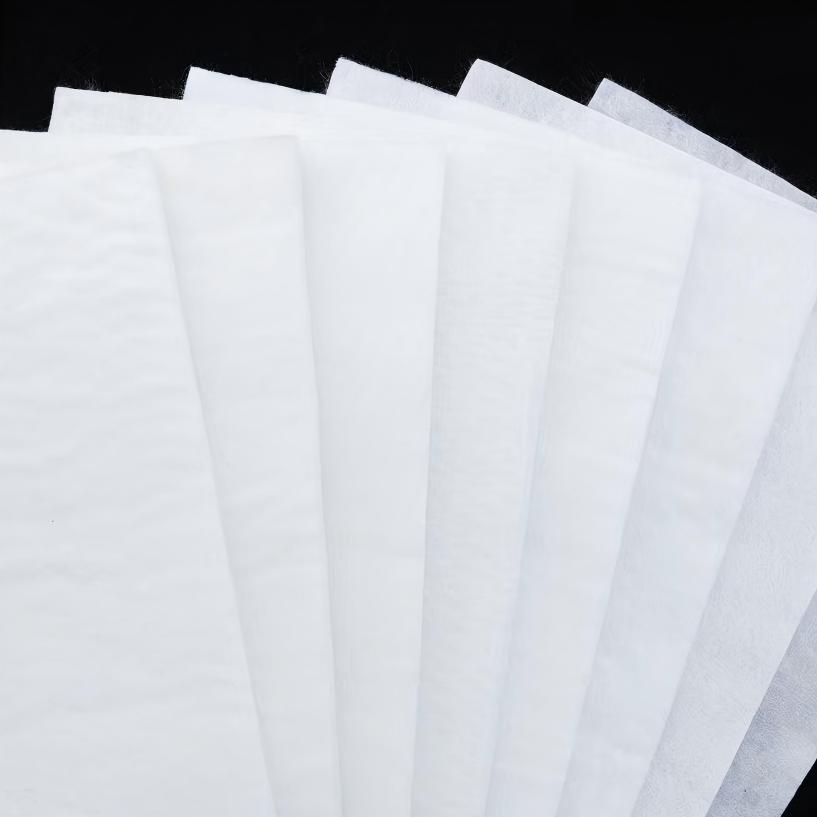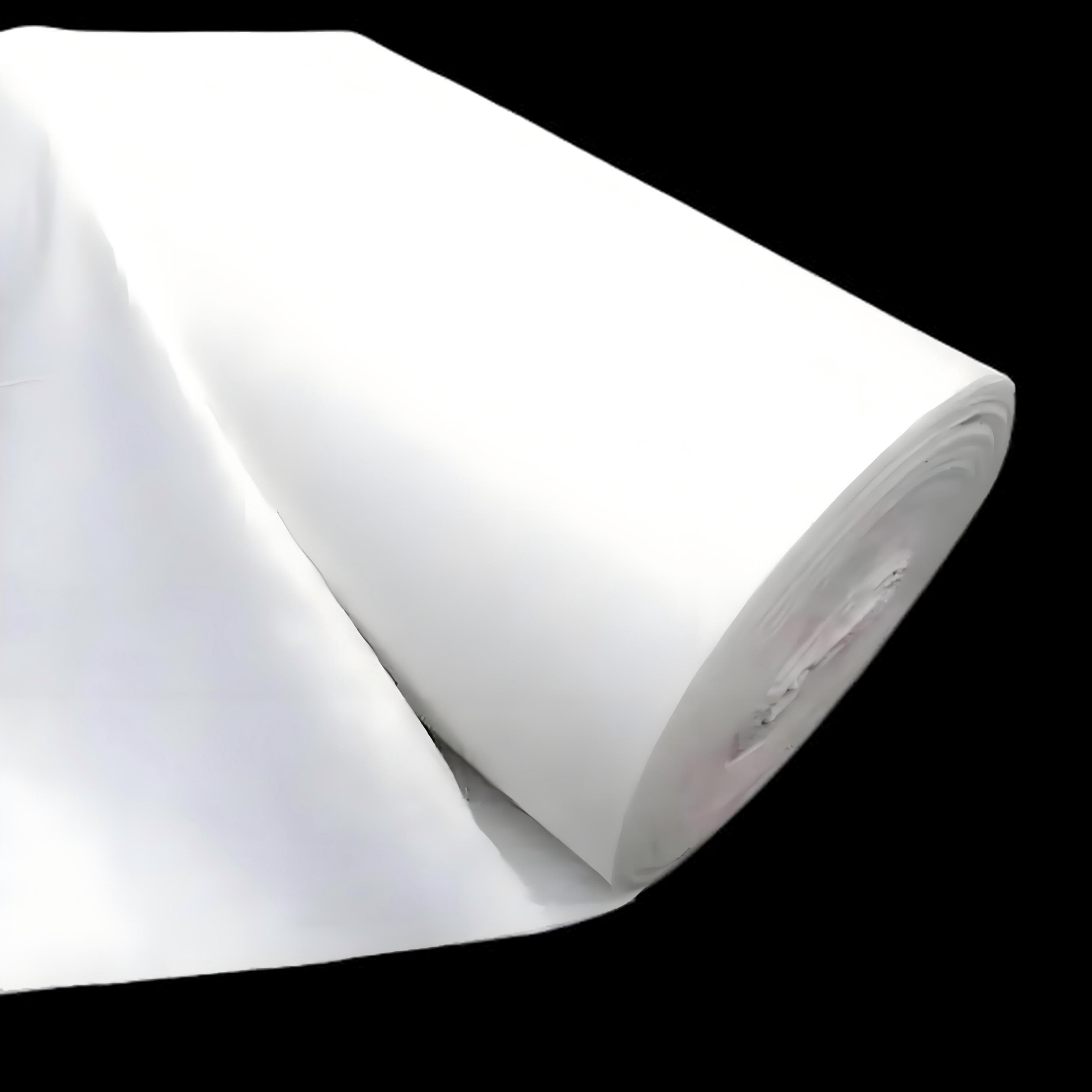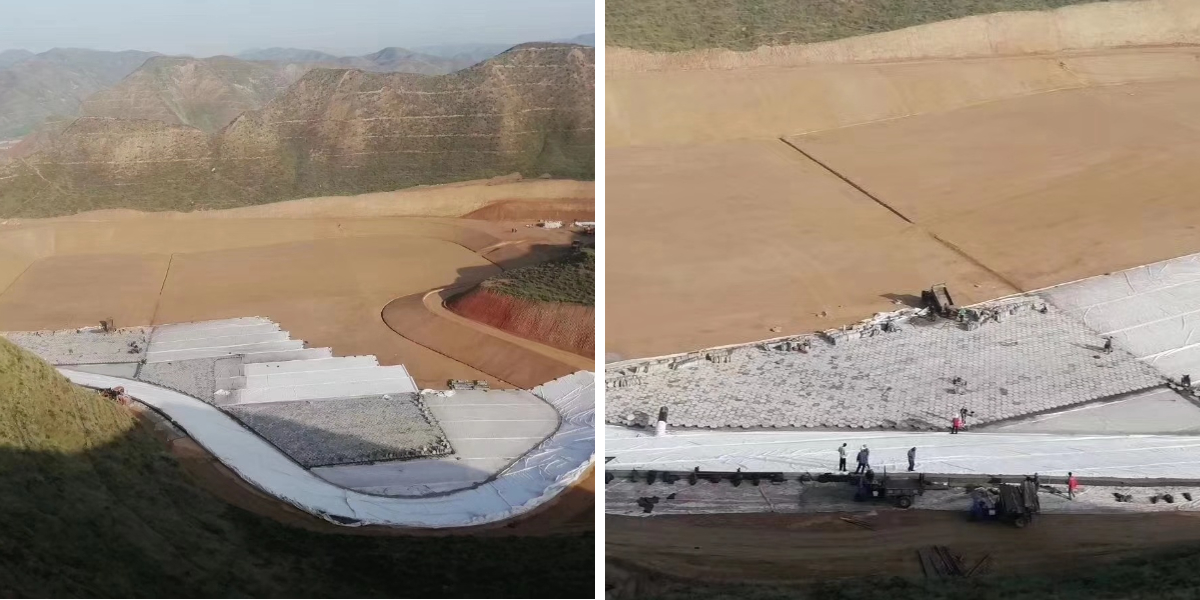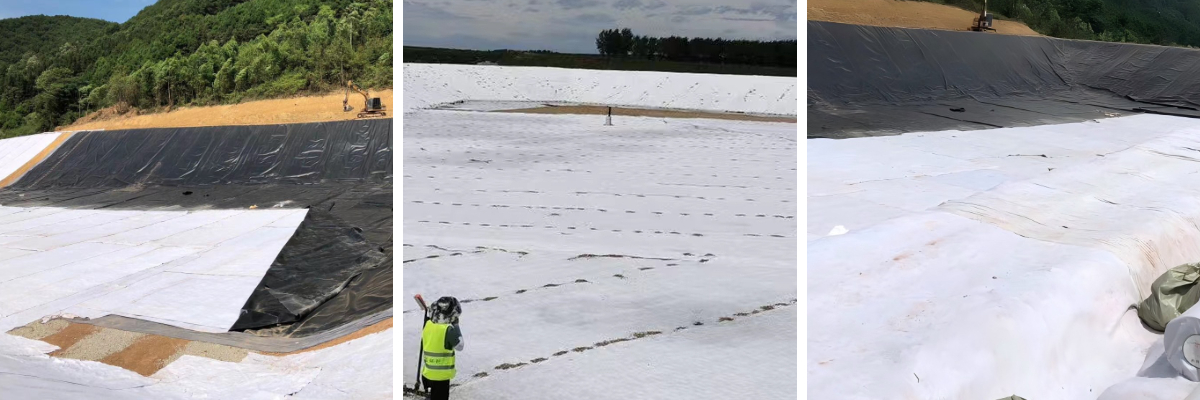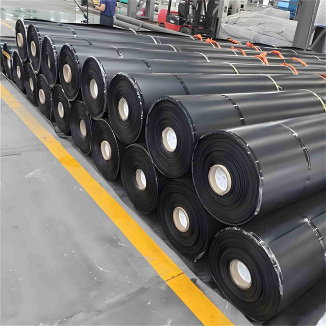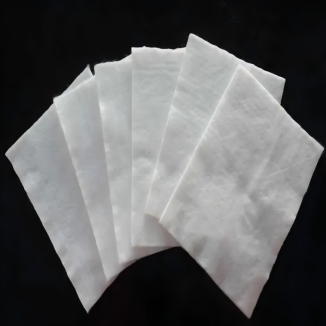Geotextile Fabric 12
1.High strength tensile resistance, stable structure:High quality fiber weaving, strong tensile and tear resistance, can disperse soil pressure, resist settlement and impact, and reduce hidden dangers of engineering damage.
2.Efficient filtration and drainage, soil conservation and flood prevention:The porous structure can intercept soil particles and quickly drain water, avoiding the erosion of the base layer by accumulated water and reducing the risk of piping and blockage.
3.Reliable anti-seepage and isolation, layered foundation protection:Tight fiber barrier with different materials mixed together, with anti-seepage effect, reduces moisture damage to the foundation layer, and extends the service life of the project.
4.Convenient and durable construction, adaptable to a wide range:Flexible texture, moderate weight, easy to cut and lay. UV resistance, acid and alkali corrosion resistance, stable performance in harsh environments.
Product Introduction
Basic attributes
Geotextile Fabric 12 is made from high-strength synthetic fibers such as polypropylene and polyester as the core raw materials, processed through professional weaving techniques. Its weight per square yard reaches the standard specification of 12 ounces, which belongs to the category of medium weight geotextiles. It not only ensures structural strength but also avoids construction inconvenience caused by excessive weight. The fabric material is flexible and elastic, presenting a uniformly distributed porous morphology on the microstructure. The porosity is moderate, allowing water infiltration and effectively intercepting soil particles. At the same time, it has excellent physical stability and can maintain stable morphology and performance under different environmental conditions such as high and low temperatures, humidity, etc., meeting the application needs of various engineering projects.
Core functions
Structural support: Relying on the high-strength tensile and tear resistance provided by high-quality fiber materials, a stable mechanical support structure is formed inside the soil. When the soil is subjected to load pressure or external impact, the fabric can evenly distribute stress to a larger range, effectively resist base settlement, deformation, and even collapse, provide continuous and stable support and guarantee for engineering structures such as roads, dams, and building foundations, and reduce the risk of structural instability.
Soil and water regulation: Utilizing its uniform porous structure to achieve synergistic effects of filtration and drainage. During the process of soil infiltration, fabrics can accurately intercept small particles in the soil, preventing them from flowing away with water and causing structural damage to the soil, thus playing a role in soil conservation and stabilization; At the same time, pore channels can quickly guide the discharge of permeable water, avoiding the accumulation of water in the base layer to form accumulated water, reducing the softening, erosion, and frost heave hazards of accumulated water on the soil, and maintaining soil water balance.
Isolation and protection: By utilizing a tight and regular arrangement of fibers, a physical barrier is formed between materials of different properties, effectively blocking the mixed infiltration of materials with different particle sizes such as sand, soil, and concrete, ensuring the purity and functional independence of each structural layer. In addition, the fabric itself has certain anti-seepage properties, which can reduce the infiltration of water into the foundation layer, reduce the erosion and damage of water to the foundation structure, and extend the service life of the engineering foundation.
Main features
Convenient and efficient construction: Due to its flexible texture and moderate weight specifications, it is easy to cut, transport, lay, and splice during the construction process. It can be flexibly adjusted according to the terrain, topography, and size requirements of the project site, and can be laid smoothly on flat, sloping, or complex terrains. When splicing, it can be quickly fixed by overlapping, sewing or hot melting, greatly shortening the construction period and improving the efficiency of the project construction.
Durable and long-lasting: After special processing, the fabric has excellent resistance to UV aging and is not easily brittle or broken even when exposed to sunlight for a long time; At the same time, it has excellent resistance to acid and alkali, as well as chemical corrosion, and can adapt to soil acidic and alkaline environments and industrial wastewater erosion; It can also resist biological erosion such as microorganisms and insect infestations, and maintain stable performance for a long time in various harsh environments such as outdoor, underground, and underwater, effectively extending the service life of the project and reducing maintenance costs in the later stage.
Good ecological and environmental compatibility: produced using biodegradable or environmentally friendly synthetic fiber raw materials, with no harmful chemical substances added during the production process, and no toxic or harmful substances released during construction and use, with minimal impact on surrounding soil, water bodies, vegetation, and ecological environment. Its air permeability can ensure the normal exchange between soil and air, promote the activity and reproduction of microorganisms in the soil, and facilitate the restoration and protection of soil ecosystems, which is in line with the green and environmentally friendly development concept of modern engineering construction.
Product Parameters
project | metric | ||||||||||
Nominal strength/(kN/m) | |||||||||||
6 | 9 | 12 | 18 | 24 | 30 | 36 | 48 | 54 | |||
1 | Longitudinal and transverse tensile strength / (kN/m) ≥ | 6 | 9 | 12 | 18 | 24 | 30 | 36 | 48 | 54 | |
2 | Maximum elongation at maximum load in longitudinal and transverse directions/% | 30~80 | |||||||||
3 | CBR top penetration strength /kN ≥ | 0.9 | 1.6 | 1.9 | 2.9 | 3.9 | 5.3 | 6.4 | 7.9 | 8.5 | |
4 | Longitudinal and transverse tearing strength /kN | 0.15 | 0.22 | 0.29 | 0.43 | 0.57 | 0.71 | 0.83 | 1.1 | 1.25 | |
5 | Equivalent aperture O.90(O95)/mm | 0.05~0.30 | |||||||||
6 | Vertical permeability coefficient/(cm/s) | K× (10-¹~10-), where K=1.0~9.9 | |||||||||
7 | Width deviation rate /% ≥ | -0.5 | |||||||||
8 | Unit area mass deviation rate /% ≥ | -5 | |||||||||
9 | Thickness deviation rate /% ≥ | -10 | |||||||||
10 | Thickness coefficient of variation (CV)/% ≤ | 10 | |||||||||
11 | Dynamic perforation | Puncture hole diameter/mm ≤ | 37 | 33 | 27 | 20 | 17 | 14 | 11 | 9 | 7 |
12 | Longitudinal and transverse fracture strength (grab method)/kN ≥ | 0.3 | 0.5 | 0.7 | 1.1 | 1.4 | 1.9 | 2.4 | 3 | 3.5 | |
13 | Ultraviolet resistance (Xenon arc lamp method) | Longitudinal and transverse strength retention rate% ≥ | 70 | ||||||||
14 | Ultraviolet resistance (fluorescence UV lamp method) | Longitudinal and transverse strength retention rate% ≥ | 80 | ||||||||
Product Application
Road engineering field
12 ounce geotextile plays a crucial role in the construction of road base and subgrade layers. It can be laid between the roadbed soil and the sand and gravel base, using its isolation function to prevent the mixing of materials of different particle sizes, avoiding the roadbed soil from being squeezed and penetrated by sand and gravel, and preventing sand and gravel particles from entering the roadbed soil and causing a decrease in structural strength. Its high-strength tensile performance can effectively disperse the stress generated by vehicle loads, reduce roadbed settlement and deformation, and delay the occurrence of road cracking, collapse and other diseases. In addition, the drainage function of the fabric can timely drain the accumulated water in the roadbed, reduce the softening erosion of moisture on the roadbed, and extend the service life of the road, especially suitable for scenarios such as soft soil roadbeds and roads in rainy areas.
Water conservancy engineering field
In hydraulic engineering, 12 ounce geotextiles are widely used in the construction of structures such as dams and channels. During the process of dam filling, laying it between the dam fill and the foundation can provide isolation and protection, prevent the mixing of dam fill and foundation soil, and ensure the stability of the dam structure. Its anti-seepage performance can reduce the leakage of the dam body, while its drainage function helps to discharge the seepage water inside the dam body, reduce the pore water pressure of the dam body, and enhance the anti sliding stability of the dam body. In channel lining engineering, fabric is laid between the lining structure and the foundation soil, which can not only isolate the foundation soil from the lining material, but also discharge the accumulated water in the foundation soil, avoiding damage to the channel due to foundation soil settlement or frost heave, and improving the water delivery efficiency and durability of the channel.
In the field of building foundation engineering
For building foundations, especially for soft soil foundation treatment, 12 ounces of geotextile is an important auxiliary material. By laying fabric on the surface of the foundation soil and using reinforced soil technology, a composite foundation structure is formed by utilizing the high-strength tensile properties of the fabric and the frictional force between the soil, which improves the bearing capacity of the foundation and reduces its settlement. In the construction of foundation backfilling, fabric can isolate the backfill soil from the original foundation soil, prevent the loss of backfill soil and disturbance of the original foundation soil, ensure the compactness and stability of the backfill foundation, and provide reliable foundation guarantee for the safe construction of buildings.
Environmental Protection and Ecological Engineering Field
12 ounce geotextile also has unique applications in environmental protection and ecological restoration projects. In the construction of landfills, it can be used as an auxiliary material for the anti-seepage isolation layer, laid under the anti-seepage membrane, to protect the anti-seepage membrane and prevent sharp gravel and soil particles from piercing the anti-seepage membrane. At the same time, its drainage function can collect and guide the leachate of garbage, avoiding the pollution of surrounding soil and groundwater by leachate. In the ecological restoration projects of rivers and lakes, fabrics can be used for soil and water conservation. They are laid on the slopes of riverbanks or lakes to prevent soil erosion and create a stable soil environment for vegetation growth. At the same time, their air permeability promotes soil microbial activity and assists in the restoration and reconstruction of ecosystems.
Transportation hub and municipal engineering field
In the construction of large venues such as airport runways and station squares in transportation hubs, 12 ounce geotextiles can be used for base reinforcement and drainage treatment. In the construction of airport runway base layer, fabrics can effectively disperse the huge load generated by aircraft takeoff and landing, reduce the fatigue damage of the base structure, and timely discharge the accumulated water in the base layer to avoid cracking of the runway due to frost heave caused by accumulated water. In the underground pipeline laying project of municipal engineering, fabric is laid during the backfilling of the pipe trench to isolate the backfill soil from the pipeline, prevent the pipeline from being crushed and damaged by the backfill soil, and assist in drainage to reduce the corrosion of the pipeline caused by accumulated water in the pipe trench, ensuring the safe operation of the underground pipeline.
12 ounce geotextile has been widely used in various fields due to its core properties such as isolation, tensile strength, drainage, and anti-seepage. In road engineering, it is laid between the roadbed and the sand and gravel base, which can prevent material mixing, disperse vehicle loads, and drain roadbed water. It is particularly suitable for soft soil roadbeds and roads in rainy areas, and can effectively delay road diseases and extend service life; In hydraulic engineering, it is used to isolate the dam body from the foundation soil during dam filling, reduce leakage and discharge seepage water to enhance stability. In channel lining, it isolates the foundation soil from the lining material, discharges accumulated water to prevent settlement and frost heave, and improves water delivery efficiency; In terms of building foundation, reinforcement technology is used to form a composite foundation during soft foundation treatment, which improves bearing capacity and reduces settlement. During backfilling construction, the backfill soil is isolated from the original foundation to prevent loss and disturbance, ensuring dense and stable backfilling; In the field of environmental protection and ecology, it can protect the anti-seepage membrane from being punctured in landfills, and at the same time guide the discharge of leachate to protect the soil and water. During the ecological restoration of rivers and lakes, it can preserve and solidify the soil, promote microbial activity, and assist in ecological reconstruction; In transportation and municipal engineering, the airport runway base is used to disperse loads, drain accumulated water to prevent cracking, and isolate backfill soil from pipelines during underground pipeline trench backfilling to avoid compression corrosion and ensure safe operation of pipelines.


